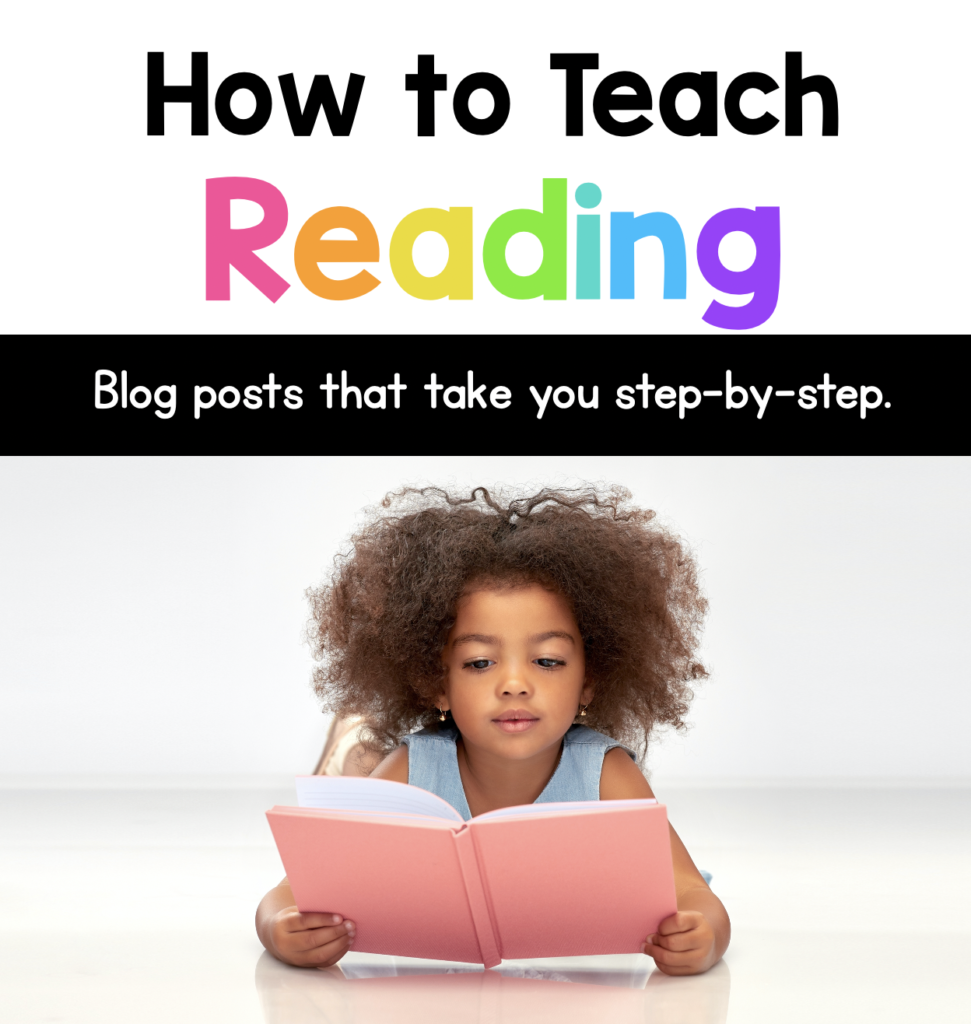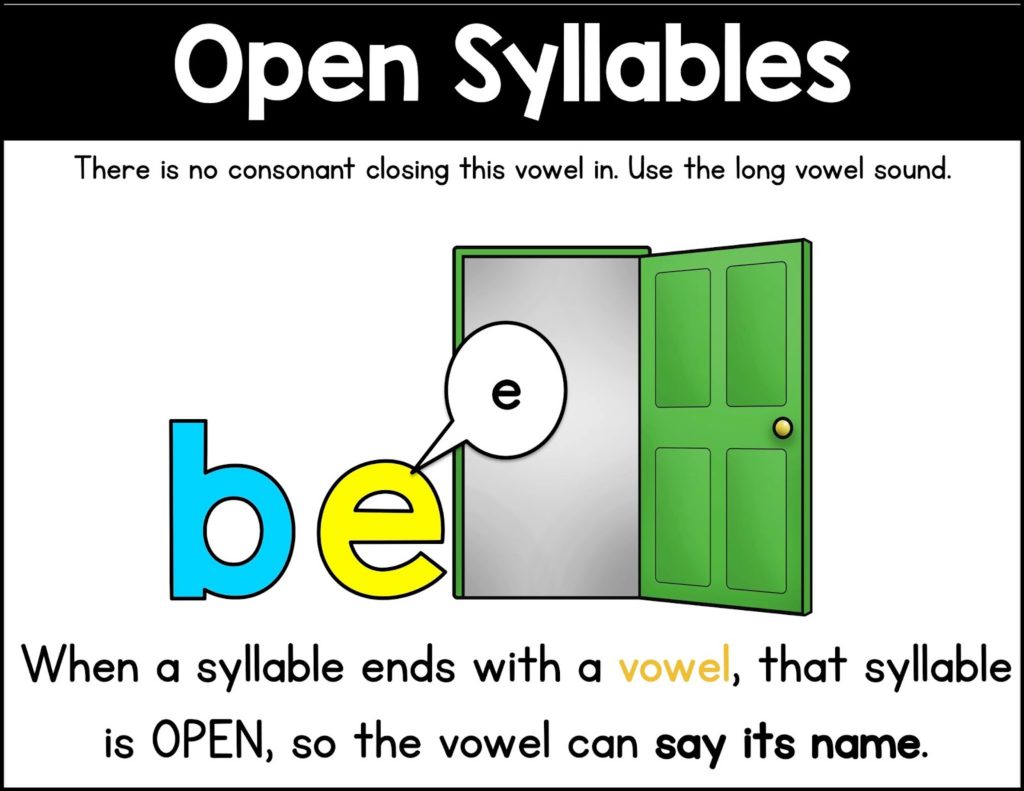Hi friends! It’s been a while, but I’m excited to say that I have several posts coming soon. I have most of them half done. LOL! I know, I know, focus Sarah! I have had a lot of questions recently about syllable types and syllable division rules, so here we are!
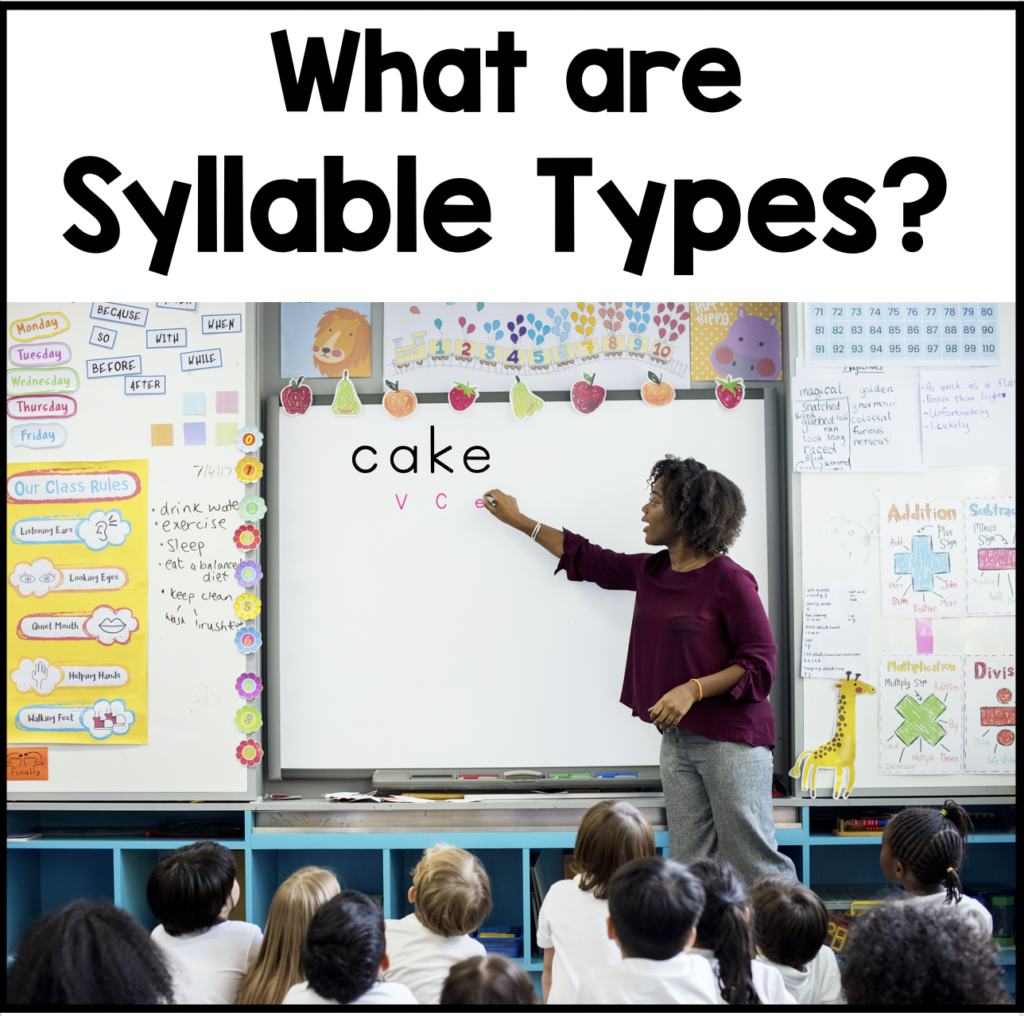
What are Syllable Types?
There are 6 written syllable types used in English spelling (7 if you separate vowel digraphs and diphthongs). Scroll all the way to the bottom of this post for free poster!
You can see them below:
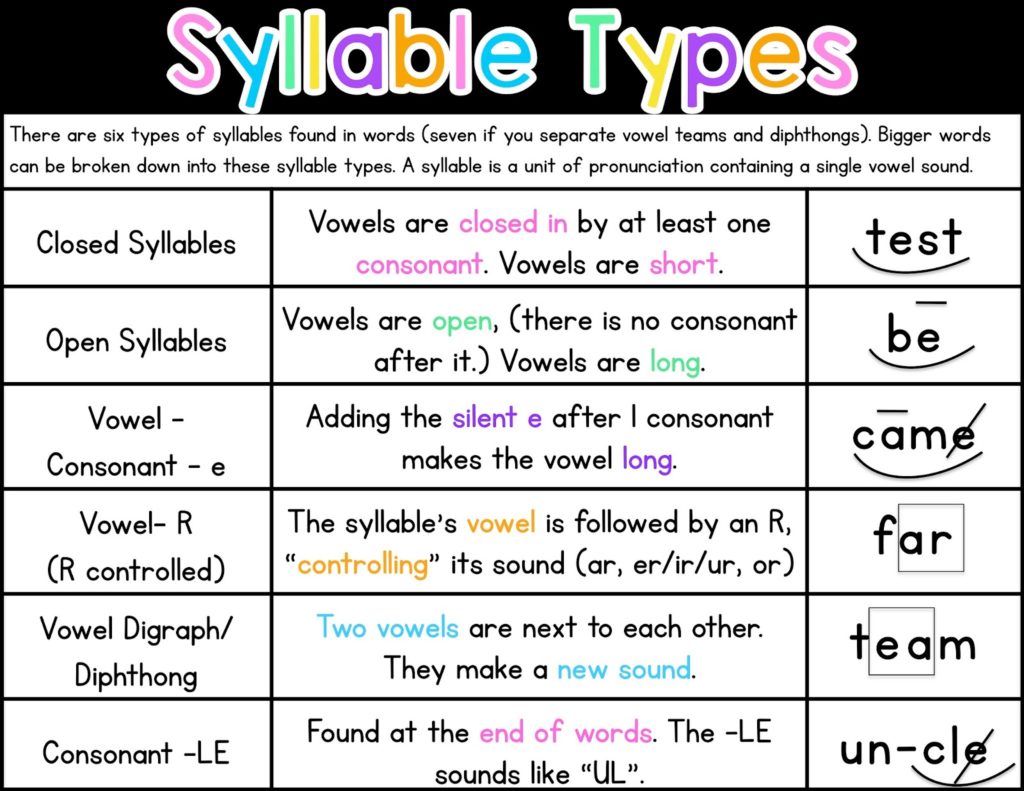
This visual shows you an example of a two-syllable word, how it would be divided, and the types of syllables in each.
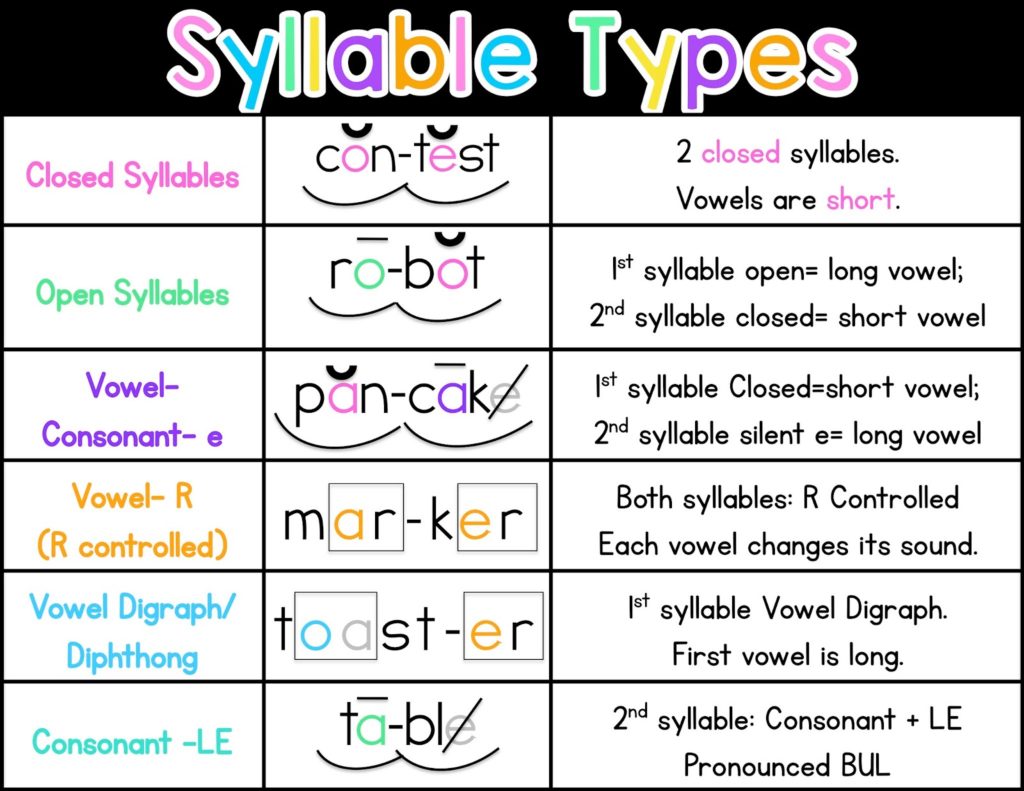
So what is a syllable? A syllable is an uninterrupted segment of sound (or a “unit of pronunciation”) with one vowel sound. Syllables are formed around a vowel sound. It’s the vowel sound that makes a syllable a syllable (vs. just being a sound or group of sounds). A syllable can be just one sound (if it is just a vowel) or many sounds (like in the word “stump” there are 5 sounds but it is still one syllable because there is one vowel sound). A word can have one syllable or several syllables. For example, “fast”, “ship”, feet”, “rain”, “light” and “be” are all one syllable because they have now vowel sound. “happy”, “basket”, “and “hammer” are all two syllables because they have two vowel sounds (you’ll see below that the /er/ sound counts as a vowel sound). You can count syllables by feeling your chin drop. That chin drop is the opening of the mouth due to a vowel sound. Sometimes syllables are referred to as the “beats” in a word. These syllables fall into one of 6 “categories”types”. A multi-syllable word can be made up of several different types of syllables or the same type of syllable.
Why Teach Syllable Types?
To read and spell, students need to know these syllable types. Knowing these syllable types makes decoding and encoding easier and more efficient. Teaching syllable types helps our students to see the patterns in words. Seeing these patterns help with decoding and encoding. Understanding syllable types helps students determine which sound the vowels will represent. Knowing the syllable types helps to narrow down what sound to make. Since every syllable must have a vowel sound, it is ALL about the vowels when I’m teaching!
Knowing syllable types especially helps when students begin reading multi-syllable words. If you are teaching your student to read multi-syllable words, instruct them to apply syllable division “rules” first. Then they can decode each syllable based on what type of syllable it is is. (Read more about syllable division here)
Closed Syllables
I teach the closed syllable type first. A closed syllable has one vowel followed by one or more consonants. This vowel is usually short (there are a few exceptions that we do teach). This is the first syllable type to teach because it is the most common. When I introduce closed syllables, I first work with VC and CVC words, then I introduce digraphs and blends to make CVCC and CCVC words. (V means vowel and C means consonant. Those are patterns. CVC would be words like “cat”, “pin”, “cub” because they have a consonant then a vowel then a consonant.)
If you would like a very detailed unit about one-syllable closed syllables, click HERE. If you would like a unit about two-syllable with closed and open syllables, click HERE.
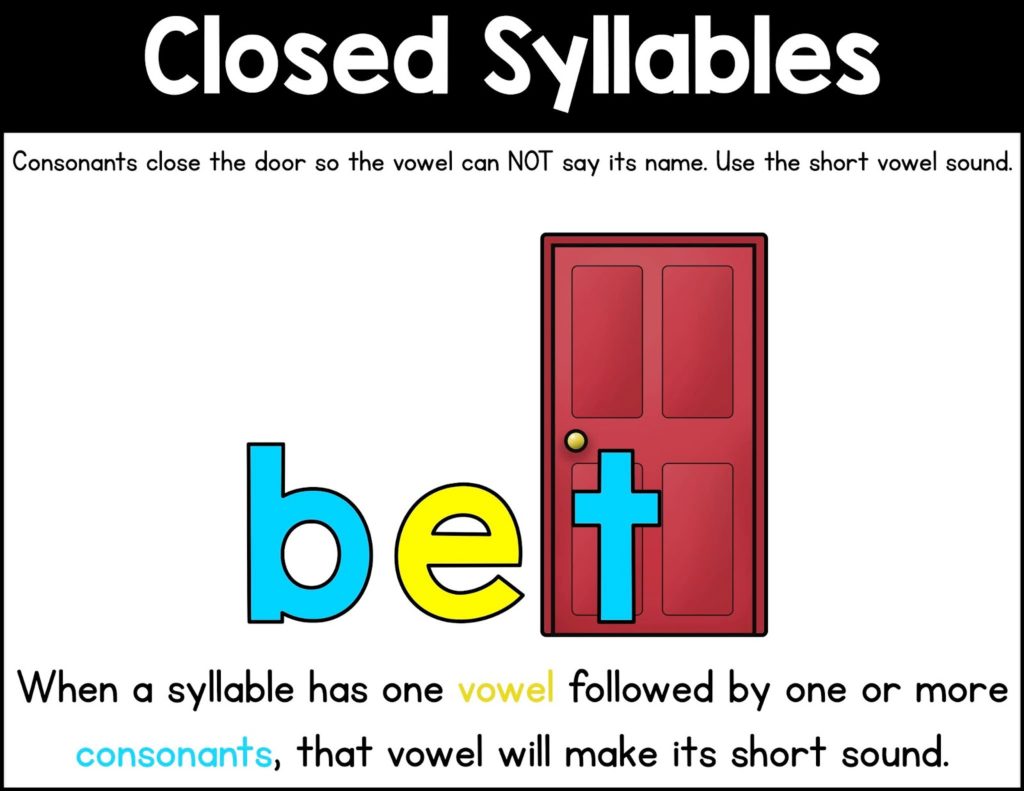
Open Syllables
Next, I teach open syllables. An open syllable ends with a vowel and that vowel makes its long sound. I tell my students that there is no consonant closing in the vowel, so the vowel can open the door and shout its name. There are not many one-syllable words that are open (me, be, she, so, why, try) but there are tons of multi-syllable words with open syllables in them. For example, the first syllable in “table” (ta), robot (ro), and bacon (ba) are all open syllables.
Open syllables include words that end in y as well (by, try, baby). The y represents a vowel sound. This is when I introduce y as a vowel.
You can find a detailed unit on open syllables HERE.
Silent e
Next, I teach the VCe pattern: When a syllable has this pattern, the letter e will be silent and the vowel will often say its long sound.
- NOTE: This “magic” e that makes the first say its name is just one of the jobs of silent e (otherwise known as the non-syllabic e). The silent e does so much more than I originally thought! Click here to read a post about the many jobs of the silent e. There is SO much more to the silent e!
Click here for resources for the silent e.
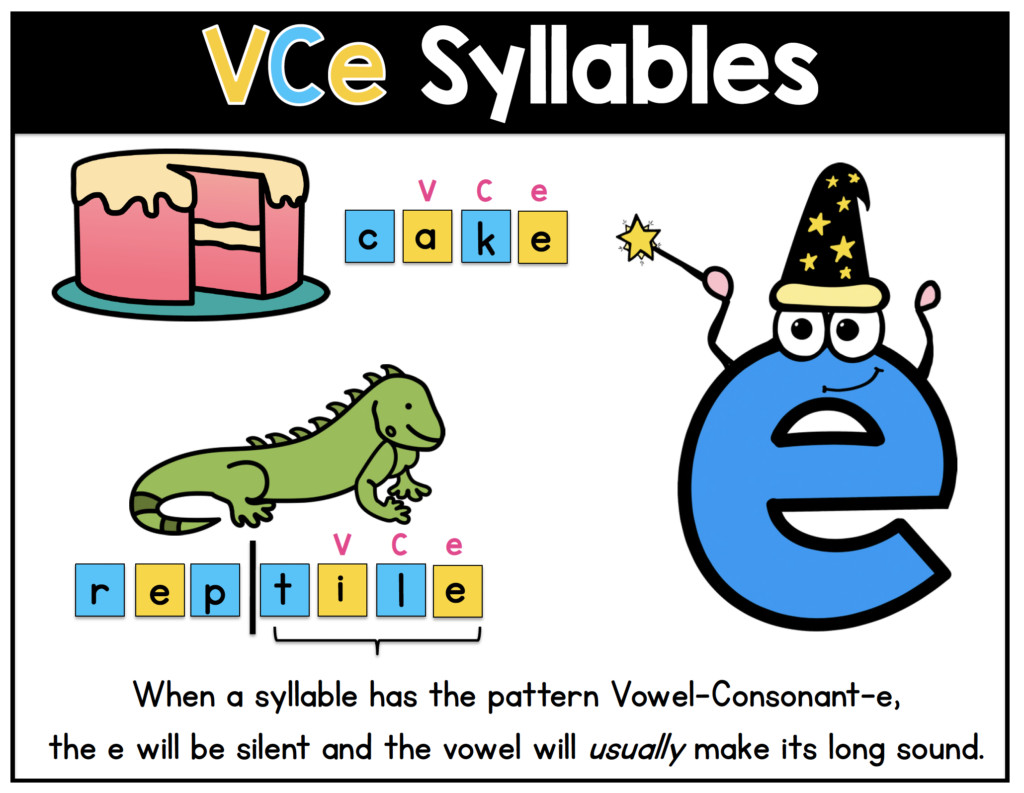
Consonant +le
Consonant + le is one of my favorites to teach because it explains so much! In fact, this is one of the other jobs of the silent e that I was talking about. The e in this syllable type is also silent but it does not make another vowel say its name. Instead, its purpose is to be a “marker”. See, every syllable must have a written vowel. This e is there to do just that. It makes this a syllable!
Unlike the other syllable types, it is never a word by itself.
It is always at the end of a word and it’s in the unaccented syllable. (What’s that? Click here to read more.)
It’s also the only syllable type where you can’t distinctly hear the vowel sound.
Consonant +le can be -cle, dle, tle, ple, fle, gle, kle, ble, and zle.

R-Controlled Vowels
R-controlled vowels are often referred to as the “Bossy r”. This is a great name because with an r-controlled vowel syllable, the r “controls” the vowel sound. Bossy r is a tricky one! It’s tricky because it only changes the vowel sound when that vowel is before the r.
Click here for my SoR Systematic Phonics: R-Controlled Vowels.
Here are some additional intervention activities bossy r resources for one-syllable words.
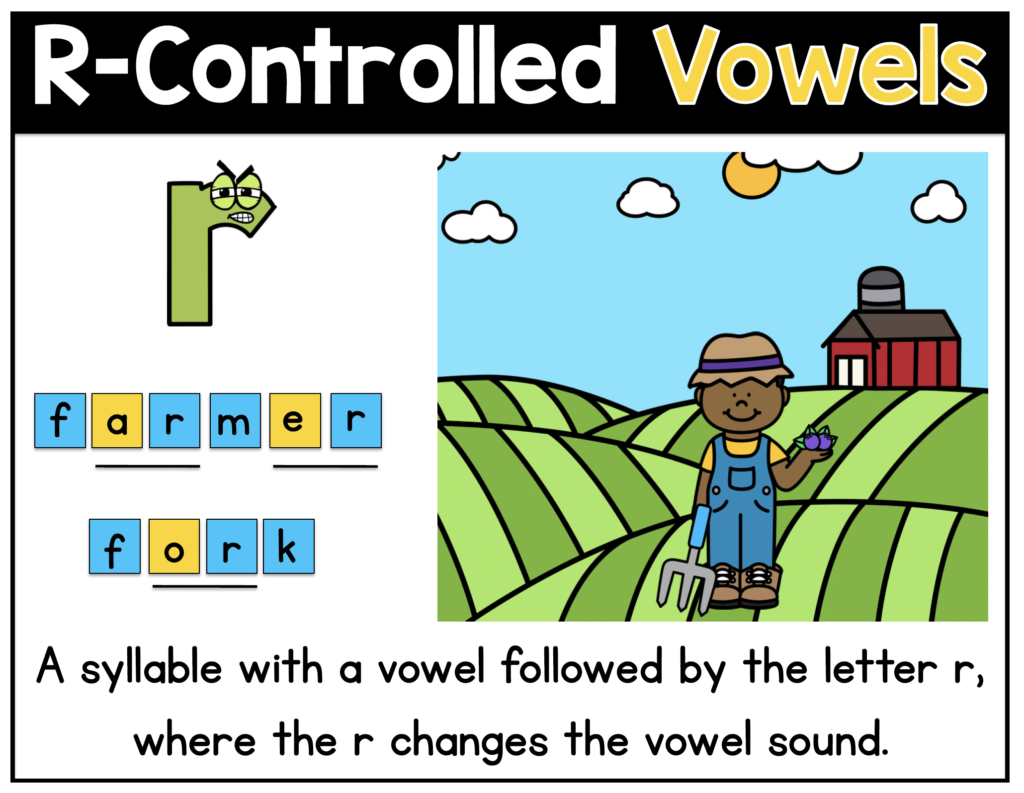
Vowel Teams
Vowel teams are two or more letters that represent one vowel sound. There are two types of vowel teams: Vowel Digraphs and Diphthongs.
Both are considered “vowel teams”, but here is the difference between the two:
- With vowel digraphs, there are two or more letters that together represent a vowel sound. For example the letters <ai> represent the long a sound. The letters <oa> can represent the long o sound. The letters <ea> can represent several sounds including long e, short e, and long a.
- Diphthongs are letter combinations that seem to make one sound, but your mouth actually does move. It is actually two sounds that slide into each other, so it just sounds like one sound. To understand the difference, say /ā/ (as in rain). Notice your mouth does not move (because this is not a diphthong). Now say /ou/. Did you notice your mouth was open then almost closed? Your lips came together while you were making that sound. That makes it a diphthong. Kids don’t need to know these terms but it is important to point out to them what their mouths are doing. Diphthongs include <ou>, <ow>, <oi>, <oy>. Diphthongs fall under the “vowels team” umbrella. In other words, diphthongs are vowel teams but vowel teams are not necessarily diphthongs.
A question I get a lot is why <ow> (as in flow) and <igh> like in “light” are considered vowel teams when they have consonants. It’s because it’s all about the sound! Those letters represent vowel sounds so they are considered vowel teams. They team up to create a vowel sound.
When I’m teaching my students, I now call them all “vowel teams” because that is easiest. I introduce vowel digraphs first. I focus on the ones that represent long vowel sounds first (ai, ay, oa, ee, etc) then later I’ll introduce what I call “other vowel teams”, which include the diphthongs (ou, ow, oi, oy) and some other vowel digraphs (ui, ew, au, etc).
To learn more about how I teach these vowel teams, check out my SoR Systematic Phonics packs. Unit 4 has long vowel teams and unit 6 has other vowel teams.
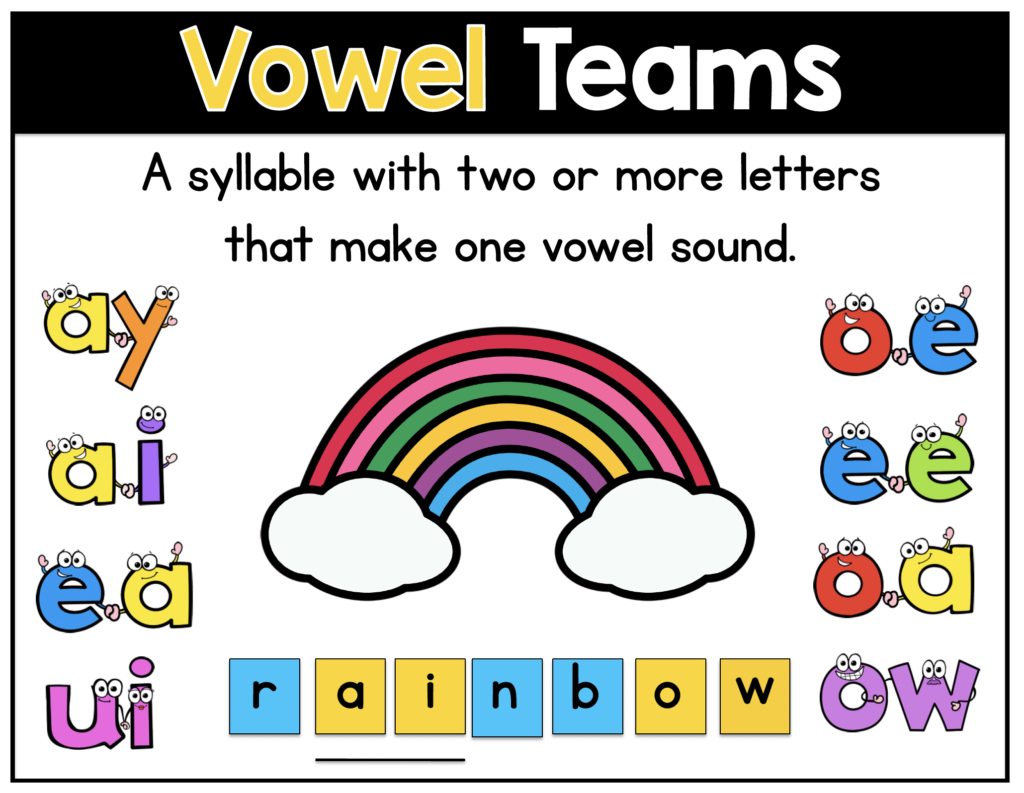
Free Poster
Below is a free poster with all of the syllable types on one page:
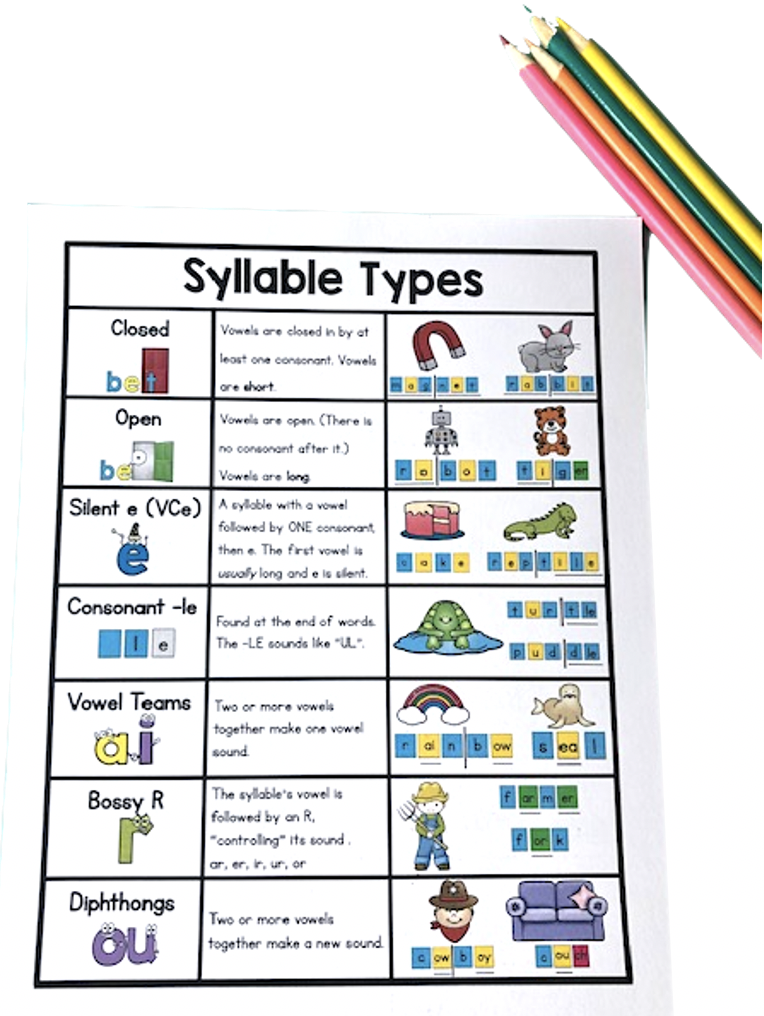
Click HERE to get this page free.
More Posters
Click HERE if you would like the posters shown on this post along with a word sort.
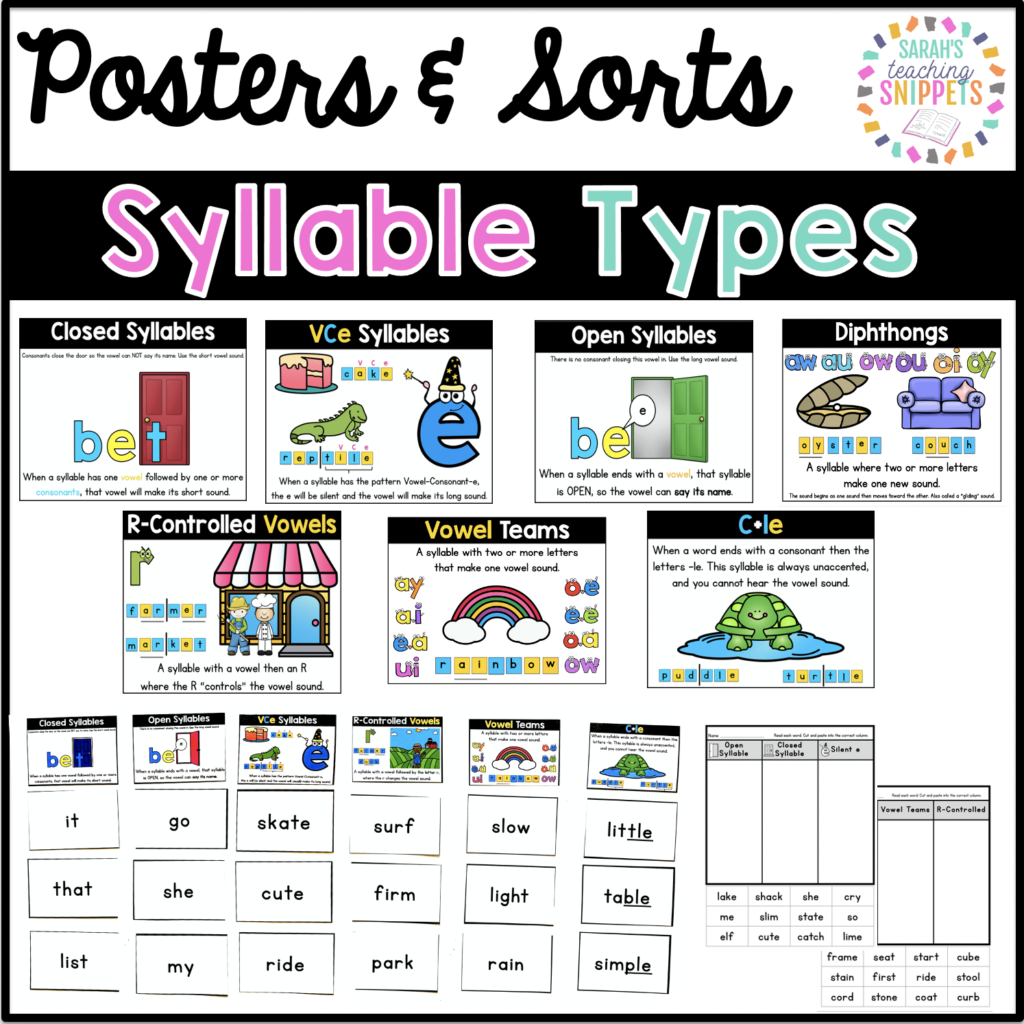
To see a video explaining these syllable types, click here.
For detailed lesson plans, interactive teaching guide, student practice pages, and more check out my SoR Systematic Phonics Units. (These posters are also included in that bundle.)
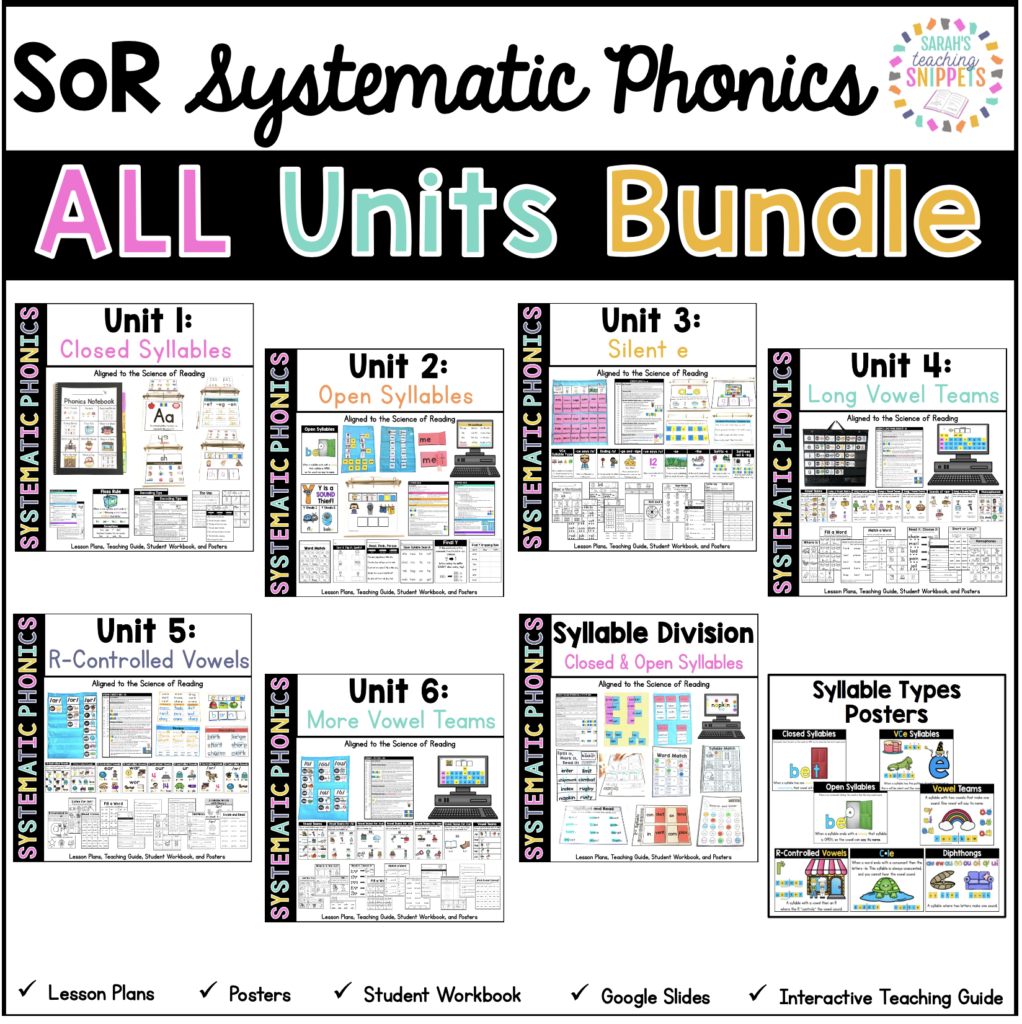
Join my mailing list for exclusive freebies and research-based resources for reading!
Related Blog Posts
Make sure you read my post about syllable division and Structured Literacy, too! Below is a link to a collection of blog posts about all things reading related.
